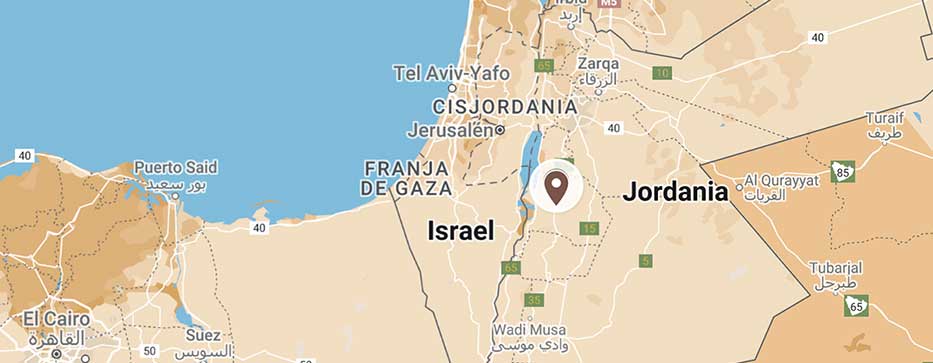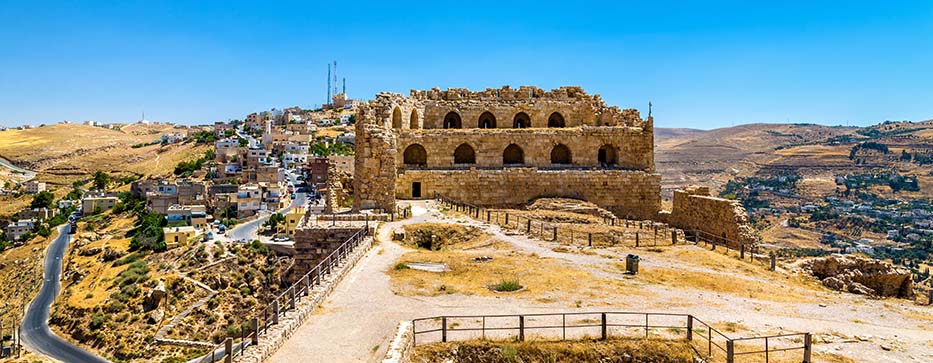Karak is an important stop on the tourist circuits of Jordan… as it was in the past on the caravan routes that ran along what is now the
King’s Road
, between Syria and Arabia or Egypt. And virtually all the attention goes to the Karak Castle, an imposing construction that takes us back to the time of the Crusades. On this page we tell you what to see in Karak, how to get here and other details of interest for your trip.
Karak It is located in the middle of the King’s Highway, which runs through the Jordanian Highlands from one end to the other. Specifically, it is located in its southern section, that is, the southernmost of Wadi Al Mujib, the rocky canyon that, for a moment, breaks the linear route of this communication route. However, it is located more or less in the center of the country, halfway between Petra and
Amman
. The city is the capital of Al Governorate. Karak and has about 40,000 inhabitants.

The history of Karak it has parallels with many other cities in the area and throughout Jordan in general. It was an important Moabite city for its strategic location, in the middle of the caravan route that connected Syria with Egypt and Arabia, and also for this reason it was used by Nabataeans, Greeks and Romans, as well as their successors the Byzantines. A good example of this importance is in its appearance in the famous mosaic map of
Madaba
.
But without a doubt, Karak It occupies a prominent place in Jordanian history thanks to the important role it played in Crusader times: the king of Jerusalem, Baldwin I, built a large castle in the mid-twelfth century, which was part of a huge network of fortresses to defend the eastern flank of his kingdom. This network also included castles such as
Shobak
, further south.
And he played that role for about half a century, because at the end of the twelfth century he was conquered by Saladin’s troops. In fact, the capture of this castle in 1183 is considered a transcendental date in that process of Arab reconquest: he besieged it for a whole year and, upon entering the castle, took the life of its lord, Renaud de Chatillon. Some time later a large equestrian statue was erected in the city in memory of that Ayyubid sultan, so idolized in the area.
In the following century, Karak Castle It was consolidated by the Mamluks, but at the end of that century it could not resist another onslaught, this time from the earth: a great earthquake caused very important damage to its structure. This was found in 1812 by Jean Louis Burckhardt, the Swiss explorer who rediscovered Petra for the Western world, who visited it on his travels in the area.
In parallel to the Karak Castle, the city was growing gradually, where Arabs and Christians coexisted, although not without conflicts: at the end of the nineteenth century, the entire Christian population was forced to leave the city after one of these confrontations, heading to Madaba, where the climate of tolerance was greater.

Except for the statue of Saladin located in the center of the city, all attention and interest is concentrated in the castle of Karak. Its figure rises imposing on top of the hill, although it is even missing important elements such as several towers, fallen during the earthquake of the thirteenth century. Its current state, however, denotes an important effort to restore and preserve the elements that have survived since then, with abundant information panels and a simple ticket office at the entrance.
This is the list of places to see in Karak, all of them within the castle grounds:
All the options to get to Karak They go through road transport. If you want to use a public and collective option, you have to arm yourself with patience: the bus station practically only receives minibuses, which do not have very regular schedules, because they only leave when they are full. Amman, Shobak or Wadi Musa are some of the populations connected in this way. Instead Karak is not part of the JETT bus company’s regular route network.
If you opt for a private vehicle or your own bus, it is easy to get here, on journeys that are not too long, since it is located in the center of the country. These are some distances and indicative durations:






Fill out the form below to receive a free non-binding quote tailor-made by a specialized agency in Jordan.
DMC travel agency specializing in tailor-made trips to Jordan
Mandala Tours, S.L, NIF: B51037471
License: C.I.AN-187782-3